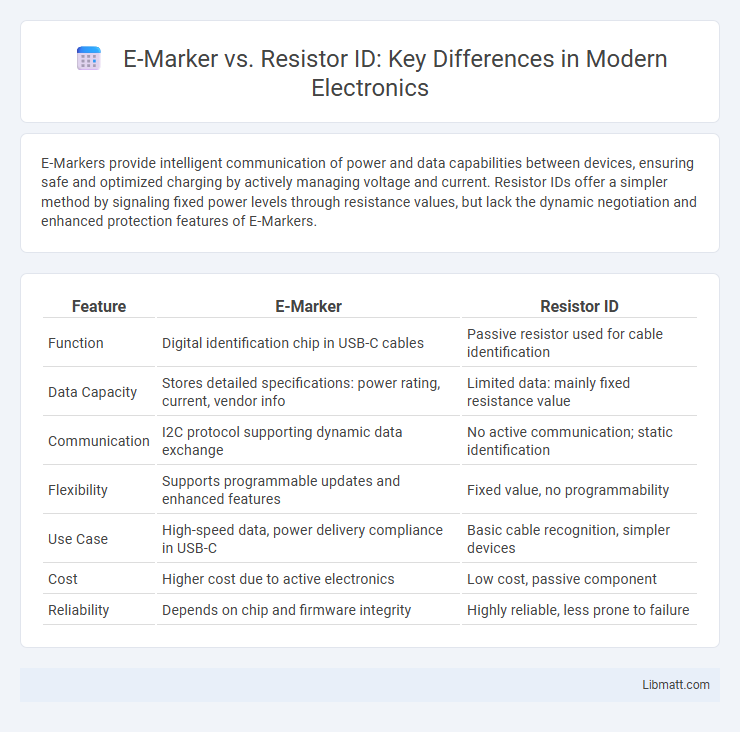E-Markers provide intelligent communication of power and data capabilities between devices, ensuring safe and optimized charging by actively managing voltage and current. Resistor IDs offer a simpler method by signaling fixed power levels through resistance values, but lack the dynamic negotiation and enhanced protection features of E-Markers.
Table of Comparison
| Feature | E-Marker | Resistor ID |
|---|---|---|
| Function | Digital identification chip in USB-C cables | Passive resistor used for cable identification |
| Data Capacity | Stores detailed specifications: power rating, current, vendor info | Limited data: mainly fixed resistance value |
| Communication | I2C protocol supporting dynamic data exchange | No active communication; static identification |
| Flexibility | Supports programmable updates and enhanced features | Fixed value, no programmability |
| Use Case | High-speed data, power delivery compliance in USB-C | Basic cable recognition, simpler devices |
| Cost | Higher cost due to active electronics | Low cost, passive component |
| Reliability | Depends on chip and firmware integrity | Highly reliable, less prone to failure |
Introduction to E-Marker and Resistor ID
E-Marker chips are integrated circuits embedded in USB Type-C cables and chargers that communicate essential power and data capabilities between devices, enabling safer and more efficient charging with variable voltage and current. Resistor ID uses fixed resistance values to identify the current carrying capacity of USB Type-C cables, providing basic safety information but lacking the dynamic communication offered by E-Markers. E-Markers enhance compatibility and power delivery negotiation beyond the static identification provided by resistor-based solutions, supporting higher wattage and advanced USB specifications.
What is an E-Marker Chip?
An E-Marker chip is an intelligent electronic component embedded in USB Type-C cables that communicates power delivery and data capabilities between connected devices. Unlike a basic resistor ID that only provides fixed current limits, the E-Marker enables dynamic negotiation of voltage and amperage for faster, safer charging. Your devices rely on the E-Marker chip for accurate recognition of cable specifications to optimize performance and prevent damage.
Overview of Resistor ID Technology
Resistor ID technology uses specific resistance values embedded in USB-C cables to communicate cable properties such as current rating and power delivery capabilities. This passive method ensures compatibility by signaling device requirements through fixed resistor values connected across designated pin pairs. While simple and cost-effective, Resistor ID lacks the dynamic data exchange and enhanced functionality provided by advanced alternatives like E-Markers.
Key Differences Between E-Marker and Resistor ID
E-Marker chips are integrated digital identifiers used in USB Type-C cables to communicate supported power and data capabilities, enabling USB Power Delivery with higher wattages and faster data transfer rates. Resistor IDs, by contrast, are passive components embedded within the cable or connector that provide basic current-carrying capacity information through fixed resistance values, supporting legacy USB charging standards. E-Markers enable dynamic, intelligent power negotiation and higher performance, while resistor IDs offer simple, static identification suitable for lower power applications.
Functionality in USB-C Cables
E-Marker chips in USB-C cables provide dynamic electronic identification, enabling precise communication of cable capabilities such as power delivery levels, data transfer rates, and compatibility with USB standards. Resistor IDs offer static identification by signaling simple attributes like current carrying capacity through fixed resistance values. Your device relies on E-Marker technology for enhanced safety and performance optimization, especially with high-speed or high-power USB-C connections.
Data Transfer and Power Delivery Support
E-Marker chips enable advanced data transfer rates up to 40Gbps and support dynamic power delivery up to 100W, ensuring optimal compatibility and performance for USB-C cables. Resistor ID technology provides basic power delivery identification but lacks the ability to negotiate higher power profiles or enhanced data transfer standards. E-Markers are essential for USB 3.1/3.2 and Thunderbolt 3/4 protocols, facilitating intelligent power delivery and high-speed data communication not achievable with simple resistor IDs.
Compatibility and Device Recognition
E-Marker chips enable dynamic identification and negotiation of USB-C cable capabilities, ensuring compatibility with devices supporting USB Power Delivery and data transfer standards. Resistor ID relies on fixed, passive resistance values for basic cable recognition but lacks the ability to communicate advanced features, limiting compatibility with evolving devices. E-Marker technology enhances device recognition accuracy by providing detailed information about cable specifications, improving safety and performance during connection.
Pros and Cons of E-Marker Solutions
E-Marker solutions provide advanced communication capabilities, enabling enhanced power delivery and data transfer negotiation for USB-C devices, which Resistor ID lacks. Their ability to dynamically manage voltage and current levels improves device safety and compatibility but introduces higher complexity and cost compared to simpler, passive Resistor ID implementations. While E-Markers excel in supporting fast charging and extended functionality, Resistor IDs remain advantageous for basic applications due to their reliability and lower expense.
Advantages and Limitations of Resistor ID
Resistor ID offers simplicity and cost-effectiveness for basic USB power delivery identification, making it suitable for low-complexity devices. Its limitations include lack of dynamic communication capabilities and inability to support advanced features like higher data rates or nuanced power negotiations. This restricts its use in modern USB-C environments where flexible and intelligent power management is crucial.
Choosing the Right Technology for Your Application
Selecting between E-Marker and Resistor ID technologies depends on your application's complexity and performance requirements. E-Marker chips offer dynamic communication and support for higher power levels up to 100W with precise identification, while Resistor ID provides a cost-effective, static solution suitable for lower power and simpler devices. Understanding your system's power delivery, data transfer needs, and cost constraints ensures you choose the right technology to optimize functionality and safety.
E-Marker vs Resistor ID Infographic

 libmatt.com
libmatt.com